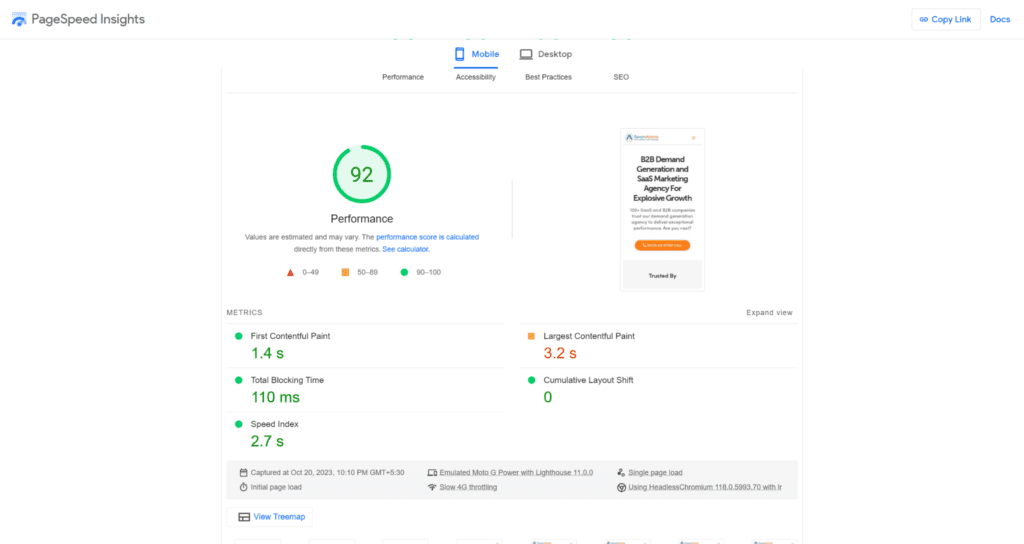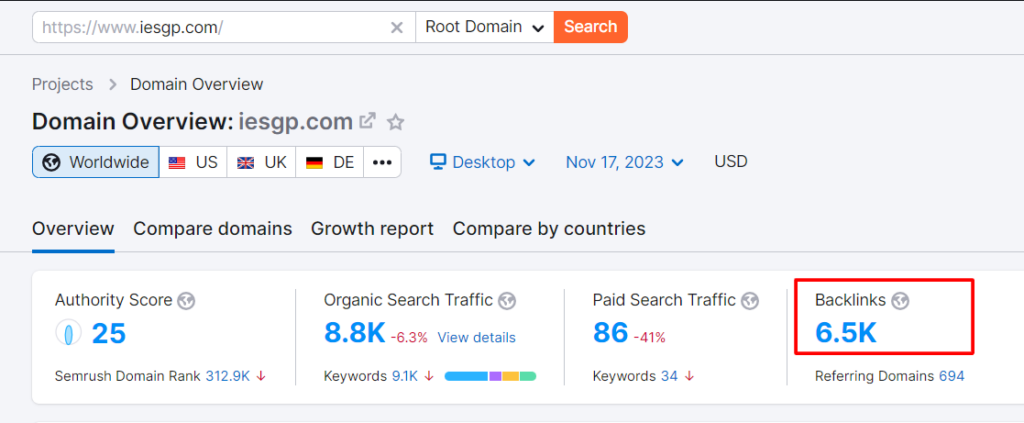Top 5 SEO Strategies for B2B Companies in 2024

If you’re experiencing a decline in your organic traffic compared to previous levels, it’s possible that this is due to recent adjustments in how Google evaluates content, which can have a significant impact on search engine rankings.
Remember, Google introduces numerous algorithm changes throughout the year, meaning that the SEO strategies that were effective in the past year or even just last month may not be suitable for the current moment.
In the dynamic world of digital marketing, maintaining a competitive edge is essential for B2B companies looking to solidify their online presence. As we embrace the year 2024, search engine optimization (SEO) remains a central force in driving online success.
In this blog post, we will explore the primary B2B SEO tactics that are ready to provide a boost to B2B companies even through Google’s algorithm changes. These B2B SEO tactics are in sync with the most current trends and algorithms within the digital landscape.
Top 5 SEO Strategies for B2B Companies in 2024
Here are some top SEO strategies for B2B companies in 2024.
These B2B SEO techniques aim to not only enhance visibility but also generate high-quality leads, which, in turn, nurture growth and enhance competitiveness in the B2B sector.
#1. Content Quality and Relevance
Creating content that is well-researched and well-written is essential. High-quality content not only provides value to the reader but also reflects positively on your brand’s authority and expertise.
Understanding your B2B audience and their pain points is crucial. Your content should directly address the issues, questions, and challenges that your potential customers are facing in their industry. This relevance ensures that your content resonates with the audience and encourages engagement.
While creating high-quality content, it’s important to include relevant keywords that your audience is likely to use in their searches. This helps search engines understand the topic of your content and rank it appropriately in search results.
Longer, comprehensive content that thoroughly covers a topic tends to perform well in search results. It’s not just about the length, but also about providing a depth of information that satisfies user intent.
Including various media types, such as images, videos, infographics, and charts, can enhance the user experience and make your content more engaging.
Focus on addressing user intent. Google’s algorithms increasingly prioritize content that directly answers the questions and needs of searchers. Analyze search queries and create content that aligns with these intents.
Monitor user engagement with your content. High click-through rates, low bounce rates, and longer time spent on a page are positive signals to search engines that your content is valuable and relevant.
Regularly update and refresh your content to keep it relevant. Outdated content may not perform as well in search results.
Creating well-researched, engaging content will not only enhance your search engine rankings but will also build credibility and trust with your target market.
#2. Mobile Optimization
A mobile-optimized website typically features a responsive design, which means that the layout and content adapt and display correctly on screens of different sizes. This ensures a consistent and user-friendly experience for both desktop and mobile users.
Google now primarily uses the mobile version of a website for indexing and ranking. This means that if your site is not mobile-friendly, it may not rank as well in search results, affecting your SEO performance.
Optimizing for mobile results in an improved user experience for visitors accessing your site on mobile devices. Websites that load quickly, feature user-friendly navigation menus, and present content in a format suitable for smaller screens have a higher likelihood of captivating and retaining mobile users.
Mobile optimization can help reduce bounce rates (visitors quickly leaving your site), which is a positive signal to search engines. When users can easily find what they’re looking for on your mobile site, they are more likely to stay and explore.
Many mobile searches have a local intent, such as finding nearby businesses. Optimizing for mobile can help improve your local SEO, making it easier for potential customers to find your B2B company when searching on their mobile devices.
Mobile users expect fast-loading pages. Mobile optimization often involves reducing page load times, which not only enhances the user experience but can also positively impact search rankings.
Mobile optimization is a key element of SEO strategies that ensures your website performs well on mobile devices, attracts and retains mobile traffic, and ultimately contributes to your online visibility and success.
As voice-activated search gains prominence on mobile devices, the significance of optimizing for voice search is growing. Mobile optimization, therefore, involves structuring your content to provide concise and voice-search-friendly responses to frequently asked questions.
#3. Voice Search Optimization
Voice searches tend to be more conversational and natural in tone. B2B companies should optimize their content to include long-tail keywords and phrases that align with how people speak rather than type.
Content that delivers clear and straightforward answers to frequently asked questions is more inclined to be featured as a snippet in voice search results. Structuring your content to answer FAQs and commonly asked questions can improve your chances of being featured.
Voice search is frequently used for local queries, such as “find B2B suppliers near me.” Ensuring that your business is listed accurately in local directories and optimizing for local SEO can enhance your visibility in voice search results.
Implementing schema markup on your website can help search engines better understand your content and make it more voice search-friendly. This can result in voice search outcomes that are more accurate and relevant.
Ensure that your company’s contact information, operating hours, and other relevant details are accurate and up to date, especially if you serve a local or regional market. This information is frequently accessed through voice search.
#4. Video SEO
Video content diversifies your online presence. When you optimize video content, it complements your written content, making your website more attractive to a broader range of users.
YouTube is the second largest search engine in the world, making video optimization crucial. Optimizing video titles, descriptions, and tags can help your videos rank well on YouTube and, by extension, in Google search results.
Including transcriptions and closed captions in your videos improves accessibility and makes your content more indexable by search engines. It also caters to viewers who prefer to watch with sound off or those with hearing impairments.
Eye-catching and relevant video thumbnails encourage more clicks. A well-optimized thumbnail can improve your video’s click-through rate in search results and on video-sharing platforms.
Include relevant keywords in your video titles and descriptions to help search engines understand the content of your video. This helps in matching your videos with user search queries.
Be mindful of video length and format. Some topics are best suited to short, snappy videos, while others benefit from in-depth, longer-form content. Consider the preferences and needs of your audience.
Creating video sitemaps can help search engines understand the structure of your video content, making it more likely to appear in video search results.
Promote your videos through social media, email marketing, and other channels. Encourage viewers to share your videos, which can result in the generation of additional backlinks and an enhancement of your SEO.
#5. Link Building
Search engines consider backlinks as votes of confidence from other websites. When authoritative and relevant websites link to your content, it enhances your site’s standing and trustworthiness within your specific industry or niche.
Quality backlinks are an important factor when it comes to search engine ranking algorithms. When you acquire links from reputable sources, it can result in higher positions in search results for targeted keywords.
Backlinks can boost your visibility on search engines and they also have the potential to generate direct referral traffic to your site. Clicks from other websites to yours expand your website’s reach to potential customers.
Earning backlinks from reputable websites is an endorsement of your content’s quality and relevance. It can encourage users to trust your information and brand, leading to increased engagement and conversions.
Building relationships with other businesses and websites in your industry is an essential part of link-building. These relationships can result in future collaboration, guest posting opportunities, and further promotion.
Guest posting on industry-related websites allows you to include backlinks to your own content. This is an effective way to not only acquire backlinks but also position yourself as an industry authority.
Collaborating with influencers and thought leaders in your niche can result in backlinks from their websites or social media profiles, exposing your content to a broader audience.
Analyzing the backlink profiles of your competitors can reveal link-building opportunities. Identify websites that link to your competitors and consider approaching them for similar link opportunities.
Wrapping Up
Remember that SEO is an ongoing process, and staying up-to-date with the latest industry trends and algorithm changes is crucial for long-term success. Adapt your B2B SEO tactic as needed to remain competitive in the ever-evolving digital landscape.
By putting the B2B SEO techniques outlined in this blog post into practice, you can confidently traverse the ever-evolving digital landscape and establish a strong online presence for your B2B company in the years to come.



